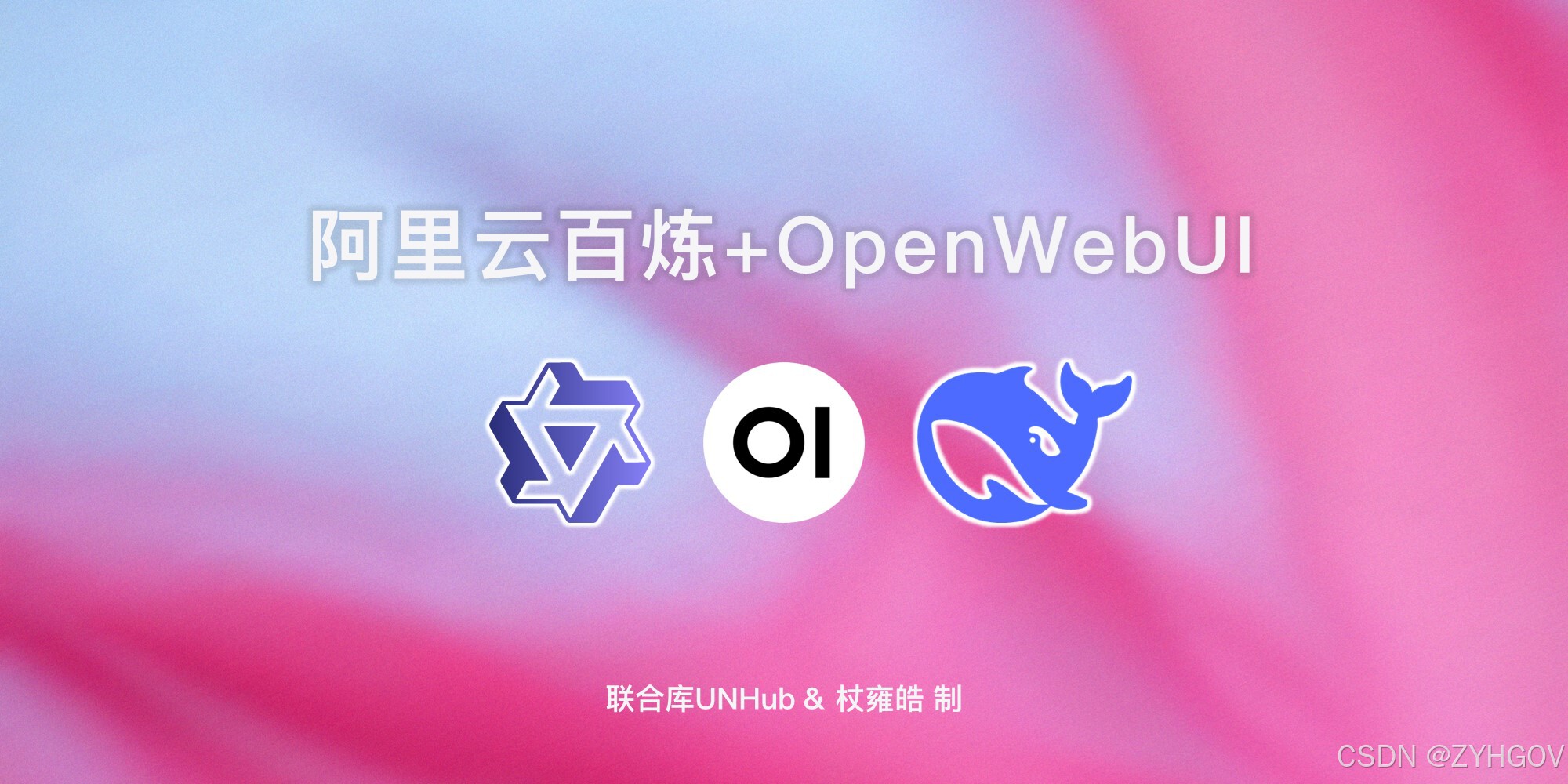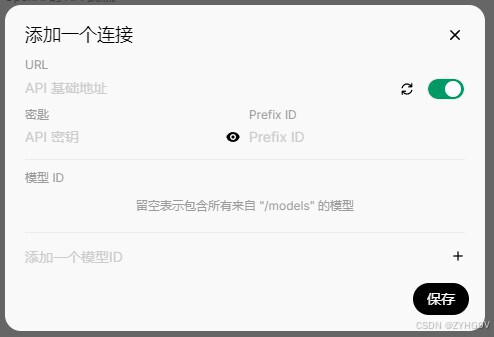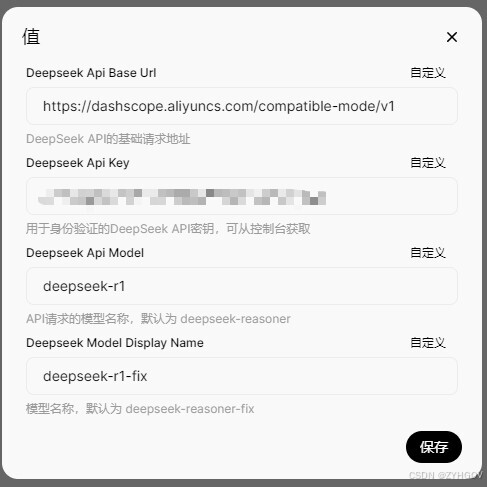如何在用python部署的 Open WebUI 中显示 DeepSeek-R1 的思考过程
一、配置管道连接
-
在 管理员面板 -> 设置 -> 外部连接 中按 + 添加一个连接。
 点击加号输入阿里云百炼的地址与api密钥
点击加号输入阿里云百炼的地址与api密钥
 此处输入网址与API-KEY
此处输入网址与API-KEY
-
网址输入https://dashscope.aliyuncs.com/compatible-mode/v1
-
密钥输入你在阿里云百炼的api密钥
二、创建函数
- 在 管理员面板 -> 函数中按 + 添加一个函数。
- 代码输入以下代码
""" title: DeepSeek R1 author: zgccrui description: 在OpwenWebUI中显示DeepSeek R1模型的思维链 - 仅支持0.5.6及以上版本 version: 1.2.10 licence: MIT """ import json import httpx import re from typing import AsyncGenerator, Callable, Awaitable from pydantic import BaseModel, Field import asyncio class Pipe: class Valves(BaseModel): DEEPSEEK_API_BASE_URL: str = Field( default="https://api.deepseek.com/v1", description="DeepSeek API的基础请求地址", ) DEEPSEEK_API_KEY: str = Field( default="", description="用于身份验证的DeepSeek API密钥,可从控制台获取" ) DEEPSEEK_API_MODEL: str = Field( default="deepseek-reasoner", description="API请求的模型名称,默认为 deepseek-reasoner", ) DEEPSEEK_MODEL_DISPLAY_NAME: str = Field( default="deepseek-reasoner-fix", description="模型名称,默认为 deepseek-reasoner-fix", ) def __init__(self): self.valves = self.Valves() self.data_prefix = "data:" self.emitter = None def pipes(self): return [ { "id": self.valves.DEEPSEEK_API_MODEL, "name": self.valves.DEEPSEEK_MODEL_DISPLAY_NAME, } ] async def pipe( self, body: dict, __event_emitter__: Callable[[dict], Awaitable[None]] = None ) -> AsyncGenerator[str, None]: """主处理管道(已移除缓冲)""" thinking_state = {"thinking": -1} # 使用字典来存储thinking状态 self.emitter = __event_emitter__ # 验证配置 if not self.valves.DEEPSEEK_API_KEY: yield json.dumps({"error": "未配置API密钥"}, ensure_ascii=False) return # 准备请求参数 headers = { "Authorization": f"Bearer {self.valves.DEEPSEEK_API_KEY}", "Content-Type": "application/json", } try: # 模型ID提取 model_id = body["model"].split(".", 1)[-1] payload = {**body, "model": model_id} # 处理消息以防止连续的相同角色 messages = payload["messages"] i = 0 while i str: """更新思考状态机(简化版)""" state_output = "" # 状态转换:未开始 -> 思考中 if thinking_state["thinking"] == -1 and delta.get("reasoning_content"): thinking_state["thinking"] = 0 state_output = "" # 状态转换:思考中 -> 已回答 elif ( thinking_state["thinking"] == 0 and not delta.get("reasoning_content") and delta.get("content") ): thinking_state["thinking"] = 1 state_output = "\n\n\n" return state_output def _process_content(self, delta: dict) -> str: """直接返回处理后的内容""" return delta.get("reasoning_content", "") or delta.get("content", "") def _format_error(self, status_code: int, error: bytes) -> str: # 如果 error 已经是字符串,则无需 decode if isinstance(error, str): error_str = error else: error_str = error.decode(errors="ignore") try: err_msg = json.loads(error_str).get("message", error_str)[:200] except Exception as e: err_msg = error_str[:200] return json.dumps( {"error": f"HTTP {status_code}: {err_msg}"}, ensure_ascii=False ) def _format_exception(self, e: Exception) -> str: """异常格式化保持不变""" err_type = type(e).__name__ return json.dumps({"error": f"{err_type}: {str(e)}"}, ensure_ascii=False)代码原创来自于如何在 Open WebUI 中显示 DeepSeek-R1 的思考过程 | HADB.ME
 https://hadb.me/posts/2025/display-deepseek-r1-thinking
https://hadb.me/posts/2025/display-deepseek-r1-thinking
- 代码输入以下代码
- 在 管理员面板 -> 函数中按 + 添加一个函数。
-
免责声明:我们致力于保护作者版权,注重分享,被刊用文章因无法核实真实出处,未能及时与作者取得联系,或有版权异议的,请联系管理员,我们会立即处理! 部分文章是来自自研大数据AI进行生成,内容摘自(百度百科,百度知道,头条百科,中国民法典,刑法,牛津词典,新华词典,汉语词典,国家院校,科普平台)等数据,内容仅供学习参考,不准确地方联系删除处理! 图片声明:本站部分配图来自人工智能系统AI生成,觅知网授权图片,PxHere摄影无版权图库和百度,360,搜狗等多加搜索引擎自动关键词搜索配图,如有侵权的图片,请第一时间联系我们。









